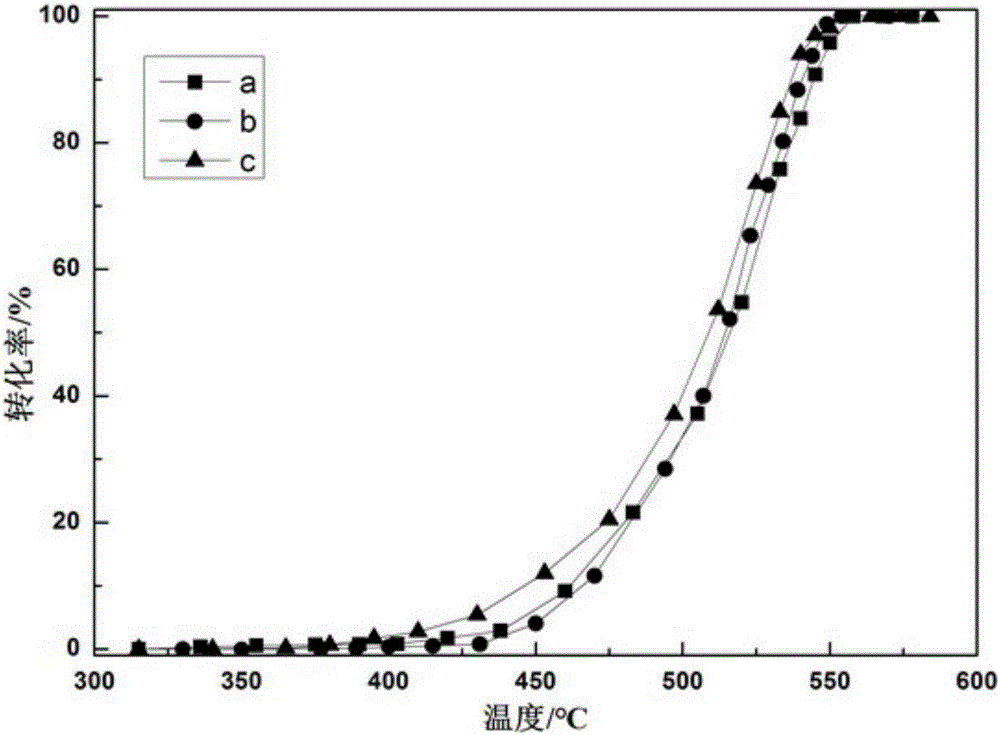Preparation method of eggshell laughing gas decomposition catalyst
A catalyst, eggshell-type technology, applied in the field of environmental catalyst preparation, can solve the problems of secondary pollution, high catalyst cost, short life, etc., and achieve the effects of improving activity and shortening mass transfer and heat transfer paths.
- Summary
- Abstract
- Description
- Claims
- Application Information
AI Technical Summary
Problems solved by technology
Method used
Image
Examples
Embodiment 1
[0021] Embodiment 1: The present shell-type laughing gas decomposition catalyst adopts the following process steps.
[0022] (1) Carrier surface modification treatment, 20g β molecular sieve was stirred in 0.1mol / L NaOH solution at 70°C for 2h at a solid-to-liquid ratio of 1:10, and then filtered and washed until neutral. Then use 0.1mol / L HNO 3 The solution was exchanged at 80°C for 3 times at a solid-to-liquid ratio of 1:10, each time for 1 hour, and filtered and washed after each exchange. After the exchange is completed, dry at 100°C for 4 hours, and finally roast the original powder to obtain the carrier powder. The temperature programming process is to increase the temperature from room temperature to 350°C at a rate of 2°C / min, keep it at 350°C for 2 hours, and then heat it at 2°C. The temperature was raised to 700°C at a rate of °C / min, kept at a temperature of 4h, and finally cooled down to room temperature naturally (the following steps and the temperature-programme...
Embodiment 2
[0025] Embodiment 2: The present shell-type laughing gas decomposition catalyst adopts the following process steps.
[0026] (1) Carrier surface modification treatment, 20g ZSM-5 molecular sieve was stirred in 0.5mol / L NaOH solution at 70°C for 2h at a solid-to-liquid ratio of 1:10, and then filtered and washed until neutral. Then exchange with 0.2mol / L HCl solution at 80°C for 3 times at a solid-to-liquid ratio of 1:10, 1 hour each time, and filter and wash after each exchange. After the exchange is completed, dry at 100° C. for 4 hours, and finally heat-programmed roast the original powder to obtain carrier powder.
[0027] (2) Carrier molding, fully mix the carrier powder obtained in step 1 with 10g of pseudo-boehmite, 5g of high-alumina cement (4:3), 0.17g (1%) of turnip powder and oxalic acid, and then mix well Add 3.5g of hydrochloric acid (10%) and 10.5mL of water dropwise to the powder, and knead, and finally put the kneaded billet into the extruder, and use different...
Embodiment 3
[0029] Embodiment 3: The present shell-type laughing gas decomposition catalyst adopts the following process steps.
[0030] (1) Carrier surface modification treatment, 20g of activated alumina molecular sieves was stirred in 0.3mol / L NaOH solution at 70°C for 2h at a solid-to-liquid ratio of 1:10, and then filtered and washed until neutral. Then use 0.15mol / L HNO 3 The solution was exchanged at 80°C for 3 times at a solid-to-liquid ratio of 1:10, each time for 1 hour, and filtered and washed after each exchange. After the exchange is completed, dry at 100° C. for 4 hours, and finally heat-programmed roast the original powder to obtain carrier powder.
[0031] (2) Carrier molding, fully mix the carrier powder obtained in step 1 with 8g of pseudo-boehmite, 2g of alumina acid (2:1), 0.15g (1%) of safflower powder and tartaric acid, and then pour the mixed Add 2.4g of malonic acid (8%) and 9.1mL of water to the powder, and knead, and finally put the kneaded billet into the extr...
PUM
 Login to View More
Login to View More Abstract
Description
Claims
Application Information
 Login to View More
Login to View More - R&D
- Intellectual Property
- Life Sciences
- Materials
- Tech Scout
- Unparalleled Data Quality
- Higher Quality Content
- 60% Fewer Hallucinations
Browse by: Latest US Patents, China's latest patents, Technical Efficacy Thesaurus, Application Domain, Technology Topic, Popular Technical Reports.
© 2025 PatSnap. All rights reserved.Legal|Privacy policy|Modern Slavery Act Transparency Statement|Sitemap|About US| Contact US: help@patsnap.com

